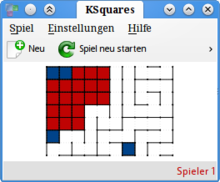Cheese box

Cheese box (also cheese box or box drawing ) is a strategy game with simple rules that is played with pen and paper. It is aimed at two, three or four players.
history
It goes back to the French La Pipopipette (probably from French: “pipeau” = “little trick, shawm” and “piperie” = “fake game” ), which was first published in 1889 by the school teacher and mathematician Édouard Lucas in the book “La Pipopipette - Nouveau Jeu de Combinaisons ” . In the same year Lucas wrote the article “Nouveaux Jeux Scientifiques de Combinaison, Dedié aux Élèves de l'École Polytechnique” in the magazine “La Nature ” . In addition, his book was published again in 1895 by the editors of "L'Arithmétique Amusante" , a collection of mathematical essays.
In the 1970s, cheese box was one of the most popular break games in German schools.
The German cheese box is slightly different from La Pipopipette . The French variant is known in the USA, but also in England and Japan, under the name "Dots & Boxes" (German: "Points and boxes" ). Game theorists have found that this variant is even NP-hard . Dots & Boxes tournaments have existed since 1994 .
The name goes back to the French la caisse (box or box), which means cheese box is a pleonasm .
Rules of the game
preparation
As a game material you need a sheet of checkered paper and at least one pen.
A rectangular field is delimited on squared paper with a pen , for beginners around 8 × 12 squares. The aim of the game is to capture the most diamonds in the field. According to other rules, the field does not necessarily have to be rectangular, it is a particular challenge to draw a "beautiful" field with corners, narrow spaces, but also longer rectangular areas, whereby you should only avoid covering a single diamond from three sides frame.
Pull
In your turn you must draw a line (i.e. reinforce the pre-printed border between two diamonds in the field).
Whoever closes a diamond with his line (that is, draws the last line around a diamond) or closes two diamonds, places his symbol (cross, circle, tick, ...) in it and it is immediately another turn. The border of the entire playing field usually counts as predetermined lines.
There is no compulsion to close a diamond with a line; you can move elsewhere without closing a diamond.
There is a compulsion to move: As long as all possible lines have not been drawn in the field, the player must draw the move until he draws a line that does not close a diamond. When all possible lines have been drawn, the game is over.
Profit
After the end of the game, the marks of all players are counted. The winner is whoever has marked the most diamonds.
variants
Dots and Boxes / La Pipopipette
In this variant, the game board consists of points that are connected to each other horizontally or vertically. In contrast to cheese boxes, the edge is also playable. Édouard Lucas originally recommended a board with 6 × 6 = 36 protruding pins (chevilles) , which should be connected with bridges (barrettes) .
Two is Better
Another variant called “Double is better” was invented in the 1970s by the cultural scientist Ralf Gering. A straight line is always drawn, which is exactly two boxes long. In the end, individual boxes can also remain neutral. Otherwise, the "German" rules are used.
Individual evidence
- ↑ http://www.duden.de/rechtschreibung/Kaesekasten Duden entry on cheese box
- ↑ Ewald Harndt: French in Berlin jargon . Stapp Verlag, Berlin 1977, 9th edition 1987, ISBN 3-87776-403-7 , p. 35.
literature
- Elwyn Berlekamp: The Dots-and-Boxes Game: Sophisticated Child's Play . AK Peters Ltd., 2000, ISBN 1-56881-129-2
- Édouard Lucas: La Pipopipette. Nouveau Jeu de Combinaison . 1889
- Édouard Lucas: Nouveaux Jeux Scientifiques . In: La Nature. Revue des sciences et de leurs applications aux arts et à l'industrie. 17th year (1889), 2nd semester, pp. 301–303 ( digital copy )
- Ian Stewart: Advanced Cheese Box . In: Spectrum of Science, May 2003, p. 114 ( excerpt )
- Ian Stewart: Dots-and-Boxes for Experts. In: Scientific American, Volume 2001, Vol. 284 (January), pp. 102-103
Web links
- Dots-and-Boxes Analysis Index - Game theory analysis of some board sizes by D. Wilson, including the C programused for this purpose(English)
- Dots and Boxes - Entry at MathWorld (English)
- Cheese Box - browser based game
